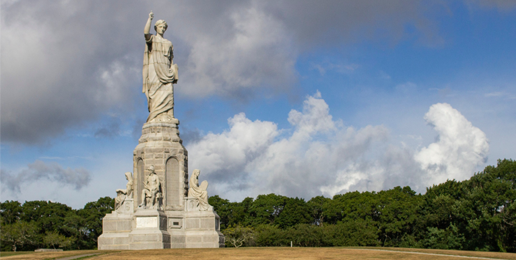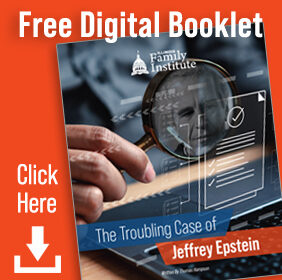
Written by Curtis Ferrin
President Joe Biden signed a proclamation at Red Butte, Arizona, on Tuesday creating the fifth national monument established during his presidency. Titled Baaj Nwaavjo I’tah Kukveni—Ancestral Footprints of the Grand Canyon—it expands the conserved Grand Canyon region by 1 million acres.
While the Grand Canyon and surrounding areas are important, President Biden’s proclamation reminded me of an underappreciated and neglected monument, which was created to help Americans understand how and why our nation came to be. This is the National Monument to the Forefathers, a monument most Americans have not heard of, that just turned 164 years old on August 1st.
This solid granite national treasure stands in a quiet neighborhood in Plymouth, Massachusetts, not far from Plymouth Rock. It commemorates the Puritans’ quest for freedom and their godly vision for human civilization, which laid the groundwork for America becoming a nation, and I believe it contains much we can learn from in our modern, upside-down culture.
You may recall multiple Old Testament instances of the patriarchs and other Israelites erecting monuments, including Jacob (Gen. 35:14), Joshua (Josh. 24:26-27), and Samuel (1 Sam. 7:12). Monuments combat humans’ natural tendency to forget significant historical events, people, and ideas by using a physical landmark. As scripture and history showcase, they often do one of two things: recall and display God’s glory or that of men.
I use the word “often” because while monuments can be harmless when they simply showcase historical events and people, there are a plethora of examples where, instead of honoring God, humans showcase their own supposed greatness, including the city of Babylon (Gen. 11:4), Saul (1 Sam. 15:12), and Absalom (2 Sam. 18:18), which resembled idols more than memorials.
This is what I believe you’ll appreciate about the National Monument to the Forefathers: like those of the Old Testament patriarchs, this monument highlights a crucial period in human history—the early Puritan settling of America over 400 years ago—but ultimately recognizes God as being critical to human freedom. If there was a “capstone” to the founding era of America, this is it. It shows us, as David Hinton puts it, “how we can preserve America as a shining city upon a hill, an example of liberty to the world,” and teaches us a vital truth our nation is forgetting: Faith in Jesus Christ is the key pillar upholding a free society.
Standing 81 feet tall and weighing 180 tons, the monument’s cornerstone was set on a hill above the Plymouth waterfront on August 1, 1859. Upon its completion exactly 30 years later, the monument was officially dedicated, memorializing America’s Christian heritage, and finally fulfilling the dream that began with the statue’s original conception in 1820. The monument, constructed out of Maine granite, features five stone statues with inscriptions and symbolism collectively creating what’s been called The Matrix of Liberty.
Towering above the monument is the first figure, Faith, displayed on a pedestal encircled by the other four. With an open Bible in her left hand and a foot on Plymouth Rock, she points to the sky, symbolizing the Christian life orientated around faith in God, including trusting Him and viewing Him as the source of wisdom, symbolized by the star on her forehead.
As the Puritans and many of America’s founders, such as William Bradford and Benjamin Rush, recognized, the God of the Bible is the only true God and Creator of the universe, and since humans are by nature religious—meaning they get their purpose and values from some authoritative source, whether that be God, themselves, or something else—for human societies to thrive, they must have true faith in the Christian God.
What does this look like in a nation? David Hinton continues:
… [T]he foundation of free nations rests in true religion… Central to the Christian faith is the message that God through Christ redeems man and gives him a living faith through a supernatural internal transformation of the heart… His Spirit gives man a new nature and writes His law upon man’s heart. This internal transformation is the beginning of building godly nations. Since only the God of the Bible can bring about this supernatural transformation, only the God of the Bible can change a nation for good.
Thus, faith must be the cornerstone of our nation for us to remain free.
Three smaller statues surround the monument to Faith. The first is Morality, who holds the Ten Commandments in her left hand and Revelation in her right. She is flanked by two reliefs, the Prophet and the Evangelist (who receive and deliver God’s revelation and His gospel to the world), and she represents the need for a nation (both the people and leaders) to be virtuous to stand the test of time. Ultimately, that moral framework can only come from faith and regeneration in God. Mandating the Christian religion does not produce regeneration nor true morality among the people, and a lack of morality destroys freedom.
The second smaller figure is Law, who sits with Justice and Mercy inscribed on either side. The laws of a nation’s government—an institution created by God—are always built on some kind of moral framework, and as we know, only Christian morality originates from the God of the Bible. Therefore, for a nation’s laws to be truly just while also making room for mercy at times, they must be informed by a societal Christian ethic.
As we have seen so far, each of the ideas symbolized by the two smaller statues requires knowledge of the truth. Thus, for a nation to continue raising Godly families, living morally, and having just and merciful laws, families must pass on this knowledge to their children. This is represented in the monument with the statue Education, a mother who sits pointing to an open Bible in her hands. The family is represented around her by two carvings: Wisdom, who resembles a grandfather, and Youth, a small child. When families raise up the next generation in the way they should go, our nation’s future looks bright.
Finally, we arrive at the culmination of a nation truly transformed by God—Liberty—the fruit of a society and culture that embeds faith into its very way of life, resulting in morality, good laws, and educated children—all necessary components of Liberty. Sitting on a throne of victory, he sits with Peace on his right and the Overthrow of Tyranny on his left. Liberty also holds a sword at rest, recognizing he must be ready to defend freedom and protect his family. Together, these four figures—Morality, Law, Education, and Liberty—represent the culture of a free nation made by the outflowing of the people’s faith.
The National Monument to the Forefathers cannot be forgotten, especially at this moment in American history when our culture needs to remember the truth. Some wonder how we got here, creating complex theories that blame Marxism in our school system, the sexual revolution, or government corruption. These explanations may sound plausible, but they’re all missing the mark. The closest argument I’ve seen explaining America’s cultural chaos is the claim that America’s declining religiosity has born this sour fruit. But even that theory gets it wrong. No, religion hasn’t declined—Christianity has—we’ve just changed our religion, worshipping ourselves rather than our Maker, and we’re no longer hiding it.
The decline of authentic Christianity among Americans directly correlates with the decline of American culture—including the rise of gender confusion, abortion, and the breakdown of the family unit. There is one true God, and it makes sense that our country would fall apart when it rejects its Creator. Until we recognize the sinful nature of man as the core problem, and the reality of God’s grace as the solution, we’ll continue helplessly watch our nation grow darker.
The message the National Monument to the Forefathers sends us is clear: the source of human flourishing is God alone. If we are to see the nation thrive, we need to faithfully share the good news of the gospel with our fellow citizens and pray that our family, neighbors, and elected leaders may come to faith in Jesus.
Freedom is a fruitful blessing from God bestowed upon a faithful people and nation, but if we idolize freedom above what God calls us to, we miss the whole point of the gospel and end up pursuing a fantasy that views the Christian faith as merely a vehicle to worldly ends, namely political freedom. Political and cultural engagement is important, but those efforts must be put into perspective with the fact that Christ is the only ultimate solution that will transform our nation.
I didn’t know this gem of a national landmark existed until a few years ago, and it gives me encouragement for our nation’s future. Every American should know about it; it’s on par with the National Mall and Mount Rushmore. If our country returns to its founding ideas—its founding faith—I am confident freedom will persist for generations to come. Tell your family, your friends, your church. Visit it if you are able.
Kirk Cameron’s film Monumental, which documents the history of the Puritans and this historical site in detail, is a must-watch. This monument is a testament to God’s sovereignty and our nation’s founding history and faith—something we can still return to—so it’s worth remembering, preserving, and sharing. God willing, the National Monument to the Forefathers will stand proudly in that quiet Plymouth neighborhood for another 164 years.
This article was originally published by the Minnesota Family Council.



















